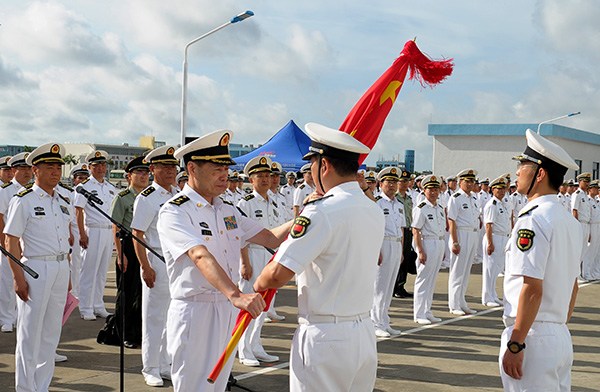
Vice-Admiral Shen Jinlong, commander of the PLA Navy, presents a flag to the Djibouti Logistics Support Base garrison at their departure ceremony at a naval port in Zhanjiang, Guangdong province, on Wednesday. PROVIDED TO CHINA DAILY
The CNS Liaoning, which docked in Hong Kong on Friday marking the 20th anniversary of the People's Liberation Army Garrison in the special administrative region, was open to the public on Saturday and Sunday, which not only allowed Hong Kong residents to get a first glimpse of the aircraft carrier but also helped instill in them a deeper sense of patriotism.
More than a week ago, on June 28, the PLA Navy launched its latest and first domestically destroyer in Shanghai. The 10,000-metric-ton vessel will be equipped with cutting-edge air defense, missile defense, anti-ship and anti-submarine missiles. As the first of China's new generation guided-missile destroyer class, or Type 055 class as experts call it, the new vessel will soon conduct mooring and sailing tests.
The vessel is a milestone in China's efforts to build a modern navy and improve its armament system. In order to build a stronger navy to protect its maritime and sovereign interests, China needs large guided-missile destroyers now that it has commissioned two aircraft carriers.
The new destroyer's colossal tonnage means it can travel farther and have stronger air defense capability, because it can be equipped with as many as 100 vertical launching units-more than what most U.S. destroyers have. That will give extra protection to China's aircraft carriers during open sea missions. The sophisticated phased array radar system and more ship-based helicopters, too, can be used on the new destroyer.
The improvements are not just in size but also in combat readiness, telecommunications and command capabilities. The new vessel is also expected to have enhanced anti-missile capabilities, including detecting, intercepting and destroying ballistic missiles fired at it.
On July 2, the United States' missile destroyer USS Stethem trespassed in China's territorial waters off the Xisha Islands in the South China Sea in what Beijing called a "serious political and military provocation". China's latest destroyer and other large vessels in the making should act as a bigger deterrent against such pugnacious intrusions.
The July 2 trespassing, however, was not Washington's first attempt to exercise "freedom of navigation" in the waters nor will it be the last. And a sophisticated combination of countermeasures, particularly more advanced, versatile warships such as the 10,000-ton destroyer, are needed to warn off the trespassing U.S. vessels.
An article published in The National Interest, a U.S. bimonthly international affairs magazine, early last month ranked China second on the list of "the five biggest navies sailing the seas today", with the U.S. in the first place. But the rankings did not tell the whole story. The U.S. Navy has by far the largest number of ships of any navy, the greatest diversity of missions and the farthest global reach. Its 10 aircraft carriers-more than those of rest of the countries put together and bigger than their foreign counterparts'-greatly contribute to its formidable naval power and presence worldwide.
In terms of the number of newly built vessels, China could be high on the list. But it has no reason to stop honing its naval prowess, including but not limited to combat capability and personnel training, because the PLA Navy has a long way to go to catch up with its U.S. counterpart in terms of the number of large warships, intelligence gathering and training. The U.S. Navy is also more combat ready because it has been actively participating in joint drills and regional wars for decades. This means China has to work harder to become a major naval power that can better defend its territorial rights and sovereignty.
The author Li Jie is a senior researcher at the Naval Military Studies Research Institute of the People's Liberation Army. The article is an excerpt from his interview with China Daily's Cui Shoufeng.


















































